BIOMOLECULES
Introduction:
In this Unit, Structures and functions of some of biomolecules will be discuss. The structure and functions of biomolecules inside the living being is studied in biochemistry. Living systems are made up of various complex biomolecules such as carbohydrates, proteins, enzymes, lipids, vitamins, hormones, nucleic acids and compounds for storage and exchange of energy such as ATP, etc.
Carbohydrates:
Classification of Carbohydrates
On the basis of their behaviour upon hydrolysis, carbohydrates can be divided into three main groups :
(C6H10O5)n + nH2O ⟶ nC6H12O6
Sugar and non-sugars : In general monosaccharides and oligosaccharides, are crystalline solids, soluble in water and sweet to taste, are collectively known as sugars. The polysaccharides, on the other hand, are amorphous insoluble in water and tasteless, are known as non-sugars.
Reducing and non-reducing carbohydrates : The carbohydrates containing free aldehydic or ketonic group can reduce Fehling’s solution and Tollen’s reagent are known as reducing carbohydrates. All monosaccharides whether aldose or ketose are reducing in nature. The carbohydrates in which the reducing parts are not free cannot reduce Fehling’s solution and Tollen’s reagent are known as non-reducing carbohydrates. All polysaccharides like starch, cellulose, glycogen etc. are non-reducing carbohydrates.
If a monosaccharide contains an aldehyde group, it is known as an aldose and if it contains a keto group, it is known as a ketose.

Glucose
Glucose occurs in nature in free as well as in the combined forms. It is present in sweet fruits and honey. Ripe grapes contain ~20% of glucose.
Preparation of Glucose
C12H22O11 + H2O ⟶ C6H12O6 + C6H12O6
(C6H10O5)n + nH2O ⟶ nC6H12O6
Structure of Glucose: Glucose is an aldohexose and is the monomer of many larger carbohydrates like starch, cellulose etc. It is the most abundant organic compound on the Earth.
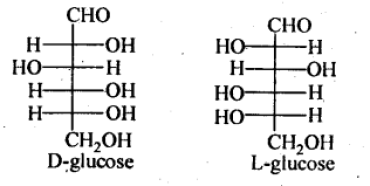
Cyclic Structure of Glucose: It was proposed that glucose can form a six-membered ring in which –OH at C-5 can add to the –CHO group and can form a cyclic hemiacetal structure. This explains the absence of –CHO group and also the existence of glucose in α and β-anomeric forms as

The two cyclic hemiacetal forms of glucose differ only in the configuration of the hydroxyl group at C-1, called anomeric carbon and the corresponding α and β-forms are called anomers. It should be noted that α and β-forms of glucose are not mirror images of each other, hence are not enantiomers.

Fructose
Fructose is an important ketohexose. It is obtained by the hydrolysis of sucrose. On the basis of molecular weight determination, elemental analysis and various reaction its molecular formula is found to be C6H12O6 and open chain structure of it can be written as
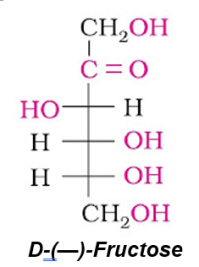
Fructose also exists in two cyclic forms like glucose i.e., α-D-(–) – fructose and β-D- (–) – fructose. The five membered cyclic structure of fructose is formed by the involvement of –OH at C-5 and carbonyl group. The five-membered ring of fructose is named as furanose with analogy to the compound furan.
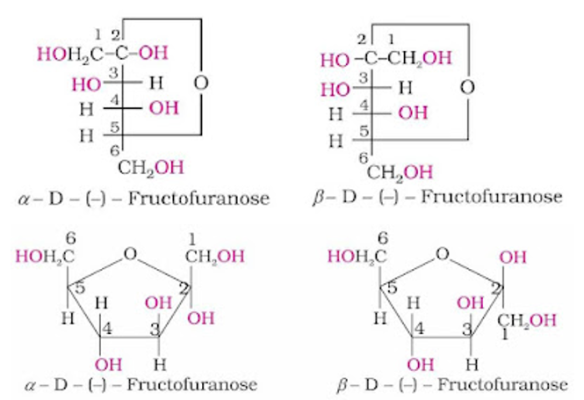
The disaccharides are composed of two units of monosaccharides. On hydrolysis with dilute acids or specific enzymes they give the corresponding monomers.
C12H22O11 + H2O ⟶ C6H12O6 + C6H12O6
In disaccharides the two monosaccharides units are joined together by an oxide linkage formed by the loss of a water molecule and the linkage is known as glycosidic linkage.
Sucrose is formed by the glycosidic linkage between C-1 of α-D-(+)-glucose and C-2 of β-D-(–) fructose:
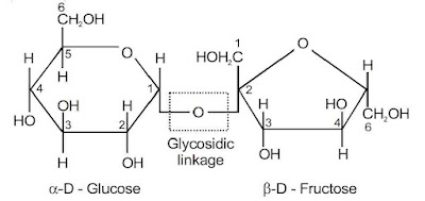
Maltose is formed by the glycosidic linkage between C-1 of one glucose unit to the C-4 of another glucose unit.

Lactose is found in milk so it is also known as milk sugar. It is formed by the glycosidic linkage between C-1 of α-D-galactose unit and C-4 of β-D-glucose unit. Lactose is a reducing sugar.
Polysaccharides are long chain polymer of monosaccharides joined together by glycosidic linkages. For example, starch, cellulose, glycogen etc. They mainly act as the food storage or structural materials.
Starch (C6H10O5)n
Starch is the main storage polysaccharide of plants. High content of starch is found in cereals, roots, tubers and some vegetables. Starch is a polymer of α-D-(+) Glucose coming of two components namely Amylose and Amylopectin.
Amylose is water soluble component, which constitutes about 15 – 20% of starch. It is a straight chain polysaccharide containing α-D-(+)-glucose units joined together by β-glycosidic linkage involving C-1 of one glucose unit and C-4 of the next.
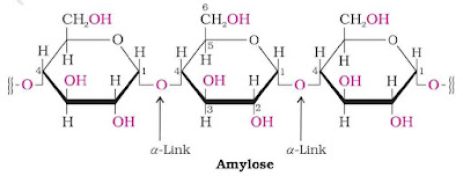
Amylopectin is a branched chain polysaccharide insoluble in water. It constitutes about 80 – 85% starch. It is a branched chain polymer of α-D-glucose units in which chain is formed by C-1 – C-4 glycosidic linkage whereas branching occurs by C-1 – C-6 glycosidic linkage.
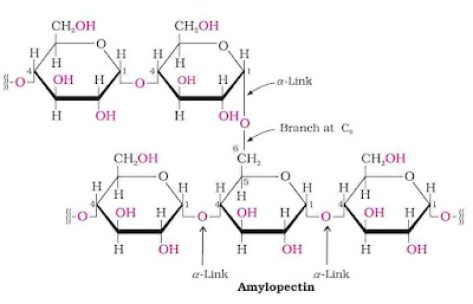
Cellulose
Cellulose is a straight chain polysaccharide composed of only β-D-glucose units. In cellulose there is β-glycosidic linkages between C-1 of one glucose unit and C-4 of the next glucose unit. Cellulose occurs mainly in plants and it is the most abundant organic substance in plant kingdom.

Glycogen
Its structure is similar to amylopectin with more branching than in amylopectin. It is also known as animal starch. In body, carbohydrates are stored as glycogen and when the body needs glucose, enzymes break the glycogen down to glucose. Glycogen is present in liver, muscle and brain.
Note : Carbohydrates are essential for life in both plants and animals. Carbohydrates are stored in plant as starch and in animals as glycogen.
Proteins:
Proteins are high molecular mass complex biopolymer of α-amino acids present in all living cells. They occur in every part of the body and form the fundamental basis of structure and functions of life. The term protein is derived from the Greek word “proteios” which means of prime importance. Proteins are the most abundant biomolecules of the living system. Chief sources of proteins are milk, cheese, pulses, peanuts, fish etc.
Amino Acids : The compound containing –NH2 and –COOH functional groups are known as amino acid, depending upon the relative position of –NH2 group with respect to –COOH group, amino acids are classified into α, β, γ, δ and so on amino acid. Hydrolysis of proteins gives only α-amino acids represented as
Essential and non-essential amino acids : The amino acids which cannot be synthesized in the body are known as essential amino acids which must be taken through diet. The amino acids, which can be synthesized in the body are known as non-essential amino acids.
Peptides: When amino acids are joined together by amide bonds, they form larger molecules called peptides and proteins.

Polypeptide : A dipeptide contains two amino acids linked by one peptide linkage, a tripeptide contains three amino acids linked by two peptide linkages and so on. When number of such amino acids is more than ten, then the products are called polypeptides.
Classification of Protein
On the basis of molecular shape, proteins are classified into two types :
Primary, Secondary, Tertiary & Quaternary Structures of Proteins :

Denaturation of Proteins : The loss in biological activity of a protein due to unfolding of globules and uncoiling of helix is called denaturation of protein. During denaturation secondary and tertiary structures are destroyed but primary structure remains intact. The coagulation of egg white on boiling is a common example of denaturation.
Enzymes:
Colloidal solution of protein which works as biological catalyst is known as enzyme. All enzymes are globular proteins. Zymase, Invertase, Maltase, Lactase, Emulsin, Urease, Pepsin, Trypsin, α-Amylase etc are the example of enzyme.
Note : The enzymes work best at an optimum temperature range of 298 K to 313 K. Their activity decreases with decrease or increase in temperature and stops at 273 K.
Properties of enzymes
It is of two types:
Nomenclature of Enzymes
Enzymes are usually named by adding the suffix ‘ase’ to the root name of the substrate, e.g., urease, maltase, invertase, etc.
Mechanism of Enzyme Action

Vitamins:
Vitamins are organic compounds which are essential for normal growth of life for animals, some bacteria and micro organism. Vitamins are not synthesized by animals (except vitamin D). Vitamins are supplied to the organism through food. They are essential dietary factor.
• Vitamins are a group of organic compounds which are essential for normal growth and nutrition and are required in very small amounts for maintaining optimum growth and a good health.
• Their absence causes specific deficiency diseases.
• Most of the vitamins cannot be synthesised in our body but plants can synthesise almost all of them.
• Vitamin D is an exception because it can be made in the skin from exposure to sunlight.
Classification of Vitamins
On the basis of solubility in water, vitamins are classified into the following two types:
• Fat soluble vitamins: Vitamins A, D, E and K are oil soluble.
• Water soluble vitamins: The group includes Vitamins B and C. These are stored in much lesser amounts in the cells.
Note: Vitamin H (Biotin) is an exception, since it is neither soluble in water nor in fat.
Some important Vitamins, their Sources and their Deficiency Diseases are dictated in the table given below
|
Name of Vitamin |
Important Sources |
Deficiency Diseases |
|
Vitamin A |
Fish liver oil, Milk, butter, egg yolk, green and yellow vegetables. |
Night blindness, Xerophthalmia (hardening of cornea of eye). |
|
Vitamin B1 |
Yeast, milk, green vegetables, cereals, fruits, egg yolk. |
Beriberi (loss of appetite, retarded growth) |
|
Vitamin B2 |
Egg yolk, liver, milk, green leafy vegetables. |
Cracked lips, sore tongue, digestive disorders and burning sensation of the skin. |
|
Vitamin B6 |
Milk, egg yolk, cereals, yeast, legumes. |
Nervous disturbances and convulsions. |
|
Vitamin B12 |
Meat, fish, kidney, eggs. |
Pernicious anaemia (RBC deficient in haemoglobin) |
|
Vitamin C |
Citrus fruits, amla and green leafy vegetables. |
Scurvy (bleeding gums) |
|
Vitamin D |
Exposure to sunlight, fish and egg yolk |
Rickets (bone deformities in children) and osteomalacia (soft bones and joint pain in adults) |
|
Vitamin E |
Milk, ghee, vegetable oils like wheat germ oil, sunflower oil, cotton seed oil. |
Increased fragility of RBCs and muscular weakness |
|
Vitamin H |
Milk, yeast, liver, kidney. |
Loss of hair, dermatitis. |
|
Vitamin K |
Green leafy vegetables, fish, meat, cereals. |
Increased blood clotting time |
Nucleic Acid:
The particles in nucleus of the cell, responsible for heredity are called chromosomes which are made up of proteins and another type of biomolecules called nucleic acid. These are natural biopolymers made of nucleotide units i.e., polynucleotides. Nucleic acid contain the elements carbon, oxygen, nitrogen and phosphorous.
Nucleic acids
They help in the role of transmission of hereditary characters and synthesis of proteins.
Each nucleotide consists of 3 parts:
Nitrogenous bases are of two types: Purines and Pyrimidines

Please note that Purines and Pyrimidines are linked together by hydrogen bonds
Types of nucleic acids
DNA
DNA contains:
RNA
It consist of:
The structure of deoxyribose and ribose sugar is given:
Structure of nucleic acids
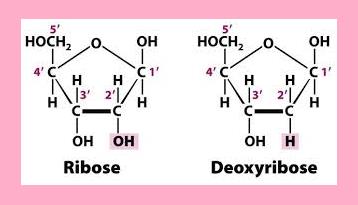

Watson and Crick model of DNA
Functions of nucleic acids
Hormones:
Hormones are molecules that act as intercellular messengers. These are produced by endocrine glands in the body and are poured directly in the blood stream which transports them to the site of action. Hormones have several functions in the body. They help to maintain the balance of biological activities in the body. Testosterone is the major sex hormone produced in males.




